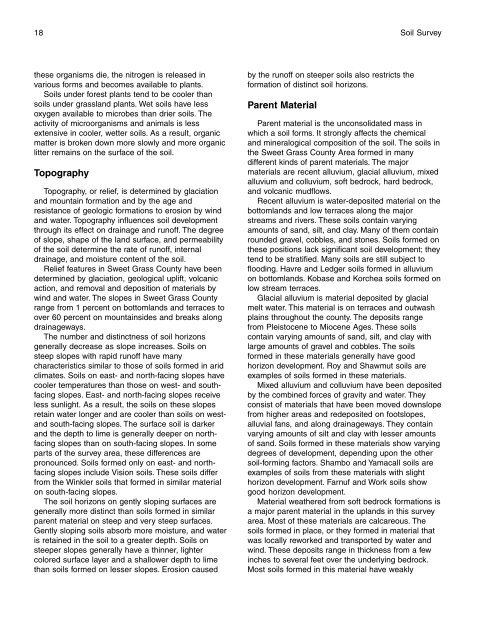Soil Survey of Sweet Grass County Area, Montana - Soil Data Mart
Soil Survey of Sweet Grass County Area, Montana - Soil Data Mart
Soil Survey of Sweet Grass County Area, Montana - Soil Data Mart
You also want an ePaper? Increase the reach of your titles
YUMPU automatically turns print PDFs into web optimized ePapers that Google loves.
18 <strong>Soil</strong> <strong>Survey</strong><br />
these organisms die, the nitrogen is released in<br />
various forms and becomes available to plants.<br />
<strong>Soil</strong>s under forest plants tend to be cooler than<br />
soils under grassland plants. Wet soils have less<br />
oxygen available to microbes than drier soils. The<br />
activity <strong>of</strong> microorganisms and animals is less<br />
extensive in cooler, wetter soils. As a result, organic<br />
matter is broken down more slowly and more organic<br />
litter remains on the surface <strong>of</strong> the soil.<br />
Topography<br />
Topography, or relief, is determined by glaciation<br />
and mountain formation and by the age and<br />
resistance <strong>of</strong> geologic formations to erosion by wind<br />
and water. Topography influences soil development<br />
through its effect on drainage and run<strong>of</strong>f. The degree<br />
<strong>of</strong> slope, shape <strong>of</strong> the land surface, and permeability<br />
<strong>of</strong> the soil determine the rate <strong>of</strong> run<strong>of</strong>f, internal<br />
drainage, and moisture content <strong>of</strong> the soil.<br />
Relief features in <strong>Sweet</strong> <strong>Grass</strong> <strong>County</strong> have been<br />
determined by glaciation, geological uplift, volcanic<br />
action, and removal and deposition <strong>of</strong> materials by<br />
wind and water. The slopes in <strong>Sweet</strong> <strong>Grass</strong> <strong>County</strong><br />
range from 1 percent on bottomlands and terraces to<br />
over 60 percent on mountainsides and breaks along<br />
drainageways.<br />
The number and distinctness <strong>of</strong> soil horizons<br />
generally decrease as slope increases. <strong>Soil</strong>s on<br />
steep slopes with rapid run<strong>of</strong>f have many<br />
characteristics similar to those <strong>of</strong> soils formed in arid<br />
climates. <strong>Soil</strong>s on east- and north-facing slopes have<br />
cooler temperatures than those on west- and southfacing<br />
slopes. East- and north-facing slopes receive<br />
less sunlight. As a result, the soils on these slopes<br />
retain water longer and are cooler than soils on westand<br />
south-facing slopes. The surface soil is darker<br />
and the depth to lime is generally deeper on northfacing<br />
slopes than on south-facing slopes. In some<br />
parts <strong>of</strong> the survey area, these differences are<br />
pronounced. <strong>Soil</strong>s formed only on east- and northfacing<br />
slopes include Vision soils. These soils differ<br />
from the Winkler soils that formed in similar material<br />
on south-facing slopes.<br />
The soil horizons on gently sloping surfaces are<br />
generally more distinct than soils formed in similar<br />
parent material on steep and very steep surfaces.<br />
Gently sloping soils absorb more moisture, and water<br />
is retained in the soil to a greater depth. <strong>Soil</strong>s on<br />
steeper slopes generally have a thinner, lighter<br />
colored surface layer and a shallower depth to lime<br />
than soils formed on lesser slopes. Erosion caused<br />
by the run<strong>of</strong>f on steeper soils also restricts the<br />
formation <strong>of</strong> distinct soil horizons.<br />
Parent Material<br />
Parent material is the unconsolidated mass in<br />
which a soil forms. It strongly affects the chemical<br />
and mineralogical composition <strong>of</strong> the soil. The soils in<br />
the <strong>Sweet</strong> <strong>Grass</strong> <strong>County</strong> <strong>Area</strong> formed in many<br />
different kinds <strong>of</strong> parent materials. The major<br />
materials are recent alluvium, glacial alluvium, mixed<br />
alluvium and colluvium, s<strong>of</strong>t bedrock, hard bedrock,<br />
and volcanic mudflows.<br />
Recent alluvium is water-deposited material on the<br />
bottomlands and low terraces along the major<br />
streams and rivers. These soils contain varying<br />
amounts <strong>of</strong> sand, silt, and clay. Many <strong>of</strong> them contain<br />
rounded gravel, cobbles, and stones. <strong>Soil</strong>s formed on<br />
these positions lack significant soil development; they<br />
tend to be stratified. Many soils are still subject to<br />
flooding. Havre and Ledger soils formed in alluvium<br />
on bottomlands. Kobase and Korchea soils formed on<br />
low stream terraces.<br />
Glacial alluvium is material deposited by glacial<br />
melt water. This material is on terraces and outwash<br />
plains throughout the county. The deposits range<br />
from Pleistocene to Miocene Ages. These soils<br />
contain varying amounts <strong>of</strong> sand, silt, and clay with<br />
large amounts <strong>of</strong> gravel and cobbles. The soils<br />
formed in these materials generally have good<br />
horizon development. Roy and Shawmut soils are<br />
examples <strong>of</strong> soils formed in these materials.<br />
Mixed alluvium and colluvium have been deposited<br />
by the combined forces <strong>of</strong> gravity and water. They<br />
consist <strong>of</strong> materials that have been moved downslope<br />
from higher areas and redeposited on footslopes,<br />
alluvial fans, and along drainageways. They contain<br />
varying amounts <strong>of</strong> silt and clay with lesser amounts<br />
<strong>of</strong> sand. <strong>Soil</strong>s formed in these materials show varying<br />
degrees <strong>of</strong> development, depending upon the other<br />
soil-forming factors. Shambo and Yamacall soils are<br />
examples <strong>of</strong> soils from these materials with slight<br />
horizon development. Farnuf and Work soils show<br />
good horizon development.<br />
Material weathered from s<strong>of</strong>t bedrock formations is<br />
a major parent material in the uplands in this survey<br />
area. Most <strong>of</strong> these materials are calcareous. The<br />
soils formed in place, or they formed in material that<br />
was locally reworked and transported by water and<br />
wind. These deposits range in thickness from a few<br />
inches to several feet over the underlying bedrock.<br />
Most soils formed in this material have weakly
















